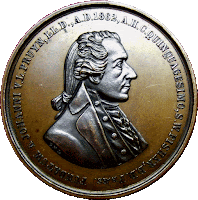HAMILTON COLLEGE MEDALS
Hamilton College began its existence in 1793 as the Hamilton-Oneida Academy. A missionary to the Oneida Indians, Samuel Kirkland, conceived of a plan for a place to help the Indians adapt to a settled life and to provide schooling for the children of the white settlers moving into central new York. During the first twenty years the school faltered and nearly failed; very few Oneidas came to the school. It was transformed into Hamilton College in 1812 - the third college to be established in the State and today one of the oldest in the nation.
Martin Hawley Medal
Silver, 41.8mm
This medal is not signed by George H. Lovett but because of
similarities with the Pruyn reverse and the fact he did work
for Hamilton College I am tentatively attributing this to him.
J.V.L Pruyn Medal
Gold, 42mm
|
|
(image courtesy of John Sallay)
Bronze, 41.75mm
Henry Curran Medal
Gold, 42mm
(image courtesy of John Sallay)
Silver, awarded to Jacob Marshall Campbell, 41.8mm
with original case of issue
with original case of issue
Tompkins Mathematical Scholarship Medal
Silver
From the "Hamilton College Catalog, One Hundred and Fourth
Year, 1915 - 1916, Clinton New York, Published by the College"
Year, 1915 - 1916, Clinton New York, Published by the College"
"TOMPKINS MATHEMATICAL PRIZES. A foundation of $1,200 by Hamilton B. Tompkins, A.M., '65, of New York, provides two prizes and four medals for juniors who excel in mathematics. The award is made upon the basis of an examination early in June, involving the mathematics of sophomore and junior years. 13 and 14."
"CURRAN AND HAWLEY MEDALS IN GREEK AND LATIN. A foundation of $700 by relatives of the late Col. Henry H. Curran, '62, of Utica, furnishes a gold medal and a silver medal for juniors who excel in classical studies. A foundation of $500 by the late Martin Hawley, ’51, of Baltimore, Md., furnishes silver medals, not exceeding four, for juniors who excel in classical studies. The award of the Curran medals is determined by written examinations in Greek and Latin; the Hawley medals are given for excellence in the entire Greek and Latin work of a year. The competition in a given year is based upon courses 9–10 (or the alternative 11–12) in Greek, and 5–6 in Latin. The first opportunity to take these courses occurs in junior year; but any senior may enter the competition who in that year is pursuing the requisite courses in both departments."












